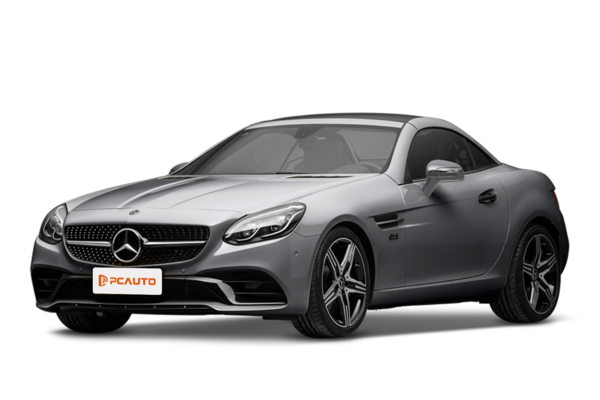Q
How about the reliability of Mercedes SLC?
The Mercedes SLC boasts high reliability. In terms of safety features, it comes standard with ABS anti - lock braking, electronic stability control, six airbags, front radar, rear parking radar, and a parking video system. These features comprehensively improve the safety of drivers and passengers and reduce the risk of accidents.
Regarding the powertrain, the SLC 200 is equipped with a 1.991L engine paired with a 9 - speed AT transmission, delivering a maximum power of 137 kilowatts and a peak torque of 300 N·m. The SLC 300, with the same engine displacement, reaches a maximum power of 182 kilowatts and a peak torque of 370 N·m, offering a stable and reliable power output.
In the suspension system, both the front and rear axles are fitted with multi - link independent suspensions. This setup can adapt to various road conditions, providing excellent handling and comfort.
Moreover, as a well - known luxury brand, Mercedes has always emphasized quality control and craftsmanship. The vehicle demonstrates outstanding durability and stability. As long as it is regularly maintained according to the maintenance manual, the Mercedes SLC can operate reliably for an extended period.
Special Disclaimer: This content is published by users and does not represent the views or position of PCauto.
Related Q&A
Q
What are the differences between SLC and SL?
Both the SLC and SL are sports cars under Mercedes-Benz, and there are differences in aspects such as vehicle positioning, price, performance, and configuration. In terms of vehicle positioning, the SLC is an entry-level sports car, while the SL is positioned more premium and belongs to the category of high - end sports cars. Regarding price, the SLC is relatively affordable. For example, the price of the 2018 Mercedes - Benz SLC 200 is RM 406,888, while the SL is more expensive. In terms of performance, taking the 2018 models as an example, the SLC 200 has a top speed of 237 km/h, and the official 0 - 100 km/h acceleration time is 6.9 seconds. The SL usually adopts a more powerful engine, offering better power performance, and its maximum speed and acceleration time may be more outstanding. In terms of configuration, the SLC is well - equipped with features like electric seats and automatic air - conditioning. On top of that, the SL has more advanced comfort and technology features, such as a more high - end audio system and intelligent driving assistance. In conclusion, the SLC is suitable for those with a limited budget who want to experience the fun of sports cars, while the SL can meet the needs of users who pursue higher performance and an ultimate luxury experience.
Q
What's the fuel consumption of Mercedes SLC?
The Mercedes SLC has different models, and their official combined fuel consumptions are different. For example, the official combined fuel consumption of the SLC 200 is 5.7L/100km, while that of the SLC 300 is 5.8L/100km. However, these are just official figures, and the actual consumption is affected by various factors.
In terms of driving habits, rapid acceleration and sudden braking can increase fuel consumption, while smooth driving helps reduce it. Regarding road conditions, frequent starting and stopping in congested urban areas will increase fuel consumption, whereas driving at a constant speed on the highway can decrease it. Overloading the vehicle, insufficient tire pressure, and long - term use of the air - conditioning can also lead to increased fuel consumption.
Therefore, the actual fuel consumption will fluctuate based on the official data, and the specific figure needs to be determined according to the actual usage situation.
Q
Where is the Mercedes SLC manufactured?
The Mercedes SLC is produced in Bremen, Germany. As a well - known German vehicle brand, Mercedes - Benz has its headquarters in Stuttgart, Germany. The factory in Bremen has approximately 12,500 employees. Apart from the SLC, it also manufactures models such as the Mercedes - Benz C - Class, E - Class, SL, GLC, and GLC Coupe. Germany has a profound heritage in automobile manufacturing and exquisite craftsmanship. Mercedes - Benz was born and developed here, and the vehicles it produces are world - famous for their high quality and high performance. Nowadays, although Mercedes - Benz has production plants all over the world, the models produced in Germany still adhere to the brand's traditional high - quality standards and exquisite technology. Take the Mercedes SLC for example, the German manufacturing endows it with excellent quality and performance.
Q
What is the fastest Mercedes SLC model?
Among the Mercedes SLC models, the 2018 Mercedes-Benz SLC 300 is the fastest. Its top speed can reach 250 km/h, and the official 0 - 100 km/h acceleration time is 5.8 seconds. It is equipped with a 2.0 - liter 4 - cylinder engine, with a maximum horsepower of 248 PS, a maximum power of 182 kw, and a maximum torque of 370 N·m. In contrast, the 2018 Mercedes - Benz SLC 200 has a top speed of 237 km/h, and the official 0 - 100 km/h acceleration time is 6.9 seconds. Its engine has a maximum horsepower of 187 PS, a maximum power of 137 kw, and a maximum torque of 300 N·m. With its stronger power output, the SLC 300 outperforms in terms of speed. Both of these two cars are rear - wheel - drive sports cars, and they also perform well in handling, bringing unique driving pleasure.
Q
What's the price of Mercedes SLC?
The Mercedes SLC provides different models, and their prices vary. Among them, the price of 2018 Mercedes - Benz SLC SLC 200 is RM 406,888, while the 2018 Mercedes - Benz SLC SLC 300 is priced at RM 479,888. Both of these cars belong to the sports car category, featuring unique designs and performance.
The SLC 200 is equipped with a 1.991L - displacement engine, with a maximum horsepower of 187PS. The SLC 300 also has a 1.991L - displacement engine, but its maximum horsepower reaches 248PS, delivering more potent output.
In terms of configuration, both models are equipped with a number of safety and comfort features. For example, they come standard with multiple airbags and vehicle stability control, which can provide drivers with a comfortable and safe driving experience.
Latest Q&A
Q
How much should I pay for a 2018 Hyundai Elantra?
The price of a 2018 Hyundai Elantra in the used car market typically ranges from RM55,000 to RM75,000, depending on factors like vehicle condition, mileage, trim level, and service history. Higher-spec 1.6L Sport or 2.0L variants might hit the upper end of that range, while base models or those with higher mileage will be cheaper. It’s advisable to get a professional inspection before buying to check the vehicle’s condition, especially critical components like the engine, transmission, and chassis. Also, verify insurance and road tax records to ensure there are no unresolved accidents or outstanding payments. As an economy sedan, the Elantra is known for its fuel efficiency and reliability, but used prices for different model years are also affected by new car market competition and model updates. So, it’s a good idea to compare quotes from multiple dealerships or private sellers and check if there’s any remaining factory warranty or extended warranty coverage, as these can impact the final transaction price. Additionally, used car loan interest rates and transfer fees should be calculated in advance to avoid exceeding your budget.
Q
Are 2018 Hyundai Elantras reliable cars?
The 2018 Hyundai Elantra delivers above-average reliability. Its powertrain uses proven 1.6L or 2.0L naturally aspirated engines paired with a 6-speed automatic transmission—a combination that's been market-tested, boasting low failure rates and reasonable routine maintenance costs. The suspension tuning leans toward comfort, making it well-suited for local road conditions, though some owners note that the sound insulation is just so-so, with noticeable tire noise at highway speeds. The Elantra's electronic systems are fairly stable, but if you're buying used, it's smart to thoroughly check that the AC system and infotainment screen are working properly. Safety features are pretty basic on this model: you get 6 airbags and stability control, but more advanced driver-assistance tech is missing. In its class, it holds its value at a mid-pack level, with a wide service network and plenty of available parts. If you're considering a used one, aim for lower mileage with complete service records, and keep an eye out for common issues like transmission hesitation or engine abnormal noise. All in all, the 2018 Elantra works well for shoppers on a budget who want a hassle-free daily driver—it offers solid all-around performance that matches its price point.
Q
How much is S70 2024 in Malaysia?
Pricing details for the 2024 Volvo S70 haven't been officially announced yet, but looking at the current S60's price range (around RM250,000 to RM300,000) and the brand's recent pricing strategies, we can expect the S70 to start at roughly RM280,000, with higher-spec variants possibly approaching RM350,000. The new model is set to carry forward Volvo's family design language and will likely feature an upgraded plug-in hybrid system – the T8 Recharge version, for instance, might deliver over 400 horsepower combined. Standard tech should include the City Safety active safety suite and Pilot Assist semi-autonomous driving aids. It's worth noting that rivals like the BMW 3 Series and Mercedes-Benz C-Class have also rolled out mild-hybrid models lately. When comparing options, shoppers should pay attention to differences in hybrid tech approaches (like 48V mild hybrids versus plug-in hybrids) and after-sales warranty policies (some brands offer 5-year/unlimited mileage coverage). If you're interested, keep an eye on the upcoming Kuala Lumpur International Motor Show or reach out to authorized dealers directly to schedule a test drive – get hands-on with the Nordic luxury sedan's driving feel and signature features like those ergonomic seats.
Q
What is the price of Honda Jazz in 2019?
Prices for the 2019 Honda Jazz in local markets vary by trim level. The base 1.5E manual starts around RM70,000, while the top-spec 1.5V Sensing CVT gets close to RM90,000 – exact figures might shift with dealer promotions or optional extras. It keeps Honda's classic practical design, packing a 1.5-liter i-VTEC engine with Earth Dreams tech that balances fuel efficiency with 131 hp, making it perfect for city drives. The standout feature? Jazz's iconic ULTRA seat system with its multiple folding setups – fold the rear seats down and you get a completely flat cargo area. That "magic seat" space concept still shines in its class. The 2019 model also added Honda SENSING on higher trims, bringing features like collision mitigation braking and lane keep assist – pretty advanced stuff for its segment back then. Looking at the used market, the 2019 Jazz holds value steadily. Well-maintained examples typically retain about 60-70% of their original price, thanks to its solid reliability reputation and affordable upkeep costs.
Q
What is the power of Honda Jazz 2019?
The 2019 Honda Jazz comes with a 1.5-liter i-VTEC naturally aspirated engine locally, churning out 120 horsepower (around 89 kW) and 145 Nm of peak torque. It's paired with either a CVT or a 6-speed manual gearbox, delivering smooth, fuel-efficient performance that's perfect for city driving. Built on Honda's classic global small car platform, the Jazz features lightweight construction combined with Earth Dreams technology, resulting in impressive fuel economy—around 5.5L/100km combined. What really stands out is its "Magic Seat" design; despite being a small car, the interior flexibility beats most rivals. Fold the rear seats flat, and you get a huge cargo area. Safety-wise, it gets VSA vehicle stability control, HSA hill-start assist, and higher trims even come with the Honda SENSING active safety suite. When stacked against competitors like the Toyota Yaris and Mazda2, the Jazz holds its own in power figures, but Honda's edge in space utilization and resale value is what keeps it a long-time favorite. If you crave more pep, keep an eye out for the later Jazz RS sport variant, which gets a more performance-focused tune.
View MoreRelated News

Mercedes-Benz invests in an autonomous driving technology company under Geely named Qianli
AshleySep 25, 2025

Benz launches its first car equipped with solid-state batteries, capable of traveling 1,205 kilometers on a full charge
WilliamSep 10, 2025

Mercedes-Benz electric vehicle design language will also undergo a major change to respond to BMW Neue Klasse.
JamesSep 9, 2025

Mercedes-Benz CLA Electric Opens for Pre-Orders with Over 700km Range
AshleyAug 14, 2025

Mercedes-Benz Unveils Bold Plan: 18 New Models by 2026
Kevin WongAug 6, 2025
View More













Pros
Cons